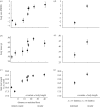Phenotypic evolution of dispersal-enhancing traits in insular voles
- PMID: 20685710
- PMCID: PMC3013397
- DOI: 10.1098/rspb.2010.1325
Phenotypic evolution of dispersal-enhancing traits in insular voles
Abstract
Evolutionary theory predicts that in metapopulations subject to rapid extinction-recolonization dynamics, natural selection should favour evolution of traits that enhance dispersal and recolonization ability. Metapopulations of field voles (Microtus agrestis) on islands in the Stockholm archipelago, Sweden, are characterized by frequent local extinction and recolonization of subpopulations. Here, we show that voles on the islands were larger and had longer feet than expected for their body size, compared with voles from the mainland; that body size and size-specific foot length increased with increasing geographical isolation and distance from mainland; and that the differences in body size and size-specific foot length were genetically based. These findings provide rare evidence for relatively recent (less than 1000 years) and rapid (corresponding to 100-250 darwins) evolution of traits facilitating dispersal and recolonization in island metapopulations.
Figures



Similar articles
-
The changing pace of insular life: 5000 years of microevolution in the Orkney vole (Microtus arvalis orcadensis).Evolution. 2014 Oct;68(10):2804-20. doi: 10.1111/evo.12476. Epub 2014 Jul 29. Evolution. 2014. PMID: 24957579 Free PMC article.
-
Local and regional determinants of colonisation-extinction dynamics of a riparian mainland-island root vole metapopulation.PLoS One. 2013;8(2):e56462. doi: 10.1371/journal.pone.0056462. Epub 2013 Feb 20. PLoS One. 2013. PMID: 23437137 Free PMC article.
-
Dwarfism in insular sloths: biogeography, selection, and evolutionary rate.Evolution. 2002 May;56(5):1045-58. doi: 10.1111/j.0014-3820.2002.tb01415.x. Evolution. 2002. PMID: 12093018
-
Body size structure of Pleistocene mammalian communities: what support is there for the "island rule"?Integr Zool. 2009 Dec;4(4):341-56. doi: 10.1111/j.1749-4877.2009.00175.x. Integr Zool. 2009. PMID: 21392307 Review.
-
Phylogenetic divergence of island biotas: Molecular dates, extinction, and "relict" lineages.Mol Ecol. 2019 Oct;28(19):4354-4362. doi: 10.1111/mec.15229. Epub 2019 Sep 23. Mol Ecol. 2019. PMID: 31544990 Review.
Cited by
-
Is the enhanced dispersal rate seen at invasion fronts a behaviourally plastic response to encountering novel ecological conditions?Biol Lett. 2016 Sep;12(9):20160539. doi: 10.1098/rsbl.2016.0539. Biol Lett. 2016. PMID: 27677818 Free PMC article.
-
Contrasting patterns of neutral and functional genetic diversity in stable and disturbed environments.Ecol Evol. 2018 Nov 11;8(23):12073-12089. doi: 10.1002/ece3.4667. eCollection 2018 Dec. Ecol Evol. 2018. PMID: 30598801 Free PMC article.
-
Molecular phylogenetic analysis of nuclear genes suggests a Cenozoic over-water dispersal origin for the Cuban solenodon.Sci Rep. 2016 Aug 8;6:31173. doi: 10.1038/srep31173. Sci Rep. 2016. PMID: 27498968 Free PMC article.
-
Spatial sorting drives morphological variation in the invasive bird, Acridotheris tristis.PLoS One. 2012;7(5):e38145. doi: 10.1371/journal.pone.0038145. Epub 2012 May 31. PLoS One. 2012. PMID: 22693591 Free PMC article.
-
Invading and expanding: range dynamics and ecological consequences of the greater white-toothed shrew (Crocidura russula) invasion in Ireland.PLoS One. 2014 Jun 23;9(6):e100403. doi: 10.1371/journal.pone.0100403. eCollection 2014. PLoS One. 2014. PMID: 24955824 Free PMC article.
References
-
- Foster J. B. 1964. Evolution of mammals on islands. Nature 202, 234–23510.1038/202234a0 (doi:10.1038/202234a0) - DOI - DOI
-
- Mayr E. 1963. Animal species and evolution. Cambridge, UK: Harvard University Press
-
- Meiri S., Cooper N., Purvis A. 2008. The island rule: made to be broken? Proc. R. Soc. B 275, 141–14810.1098/rspb.2007.1056 (doi:10.1098/rspb.2007.1056) - DOI - DOI - PMC - PubMed
-
- Millien V. 2006. Morphological evolution is accelerated among island mammals. PLoS Biol 4, e321.10.1371/journal.pbio.0040321 (doi:10.1371/journal.pbio.0040321) - DOI - DOI - PMC - PubMed
-
- Whittaker R. J., Triantis K. A., Ladle R. J. 2008. A general dynamic theory of oceanic island biogeography. J. Biogeogr. 35, 977–99410.1111/j.1365-2699.2008.01892.x (doi:10.1111/j.1365-2699.2008.01892.x) - DOI - DOI
Publication types
MeSH terms
LinkOut - more resources
Full Text Sources

